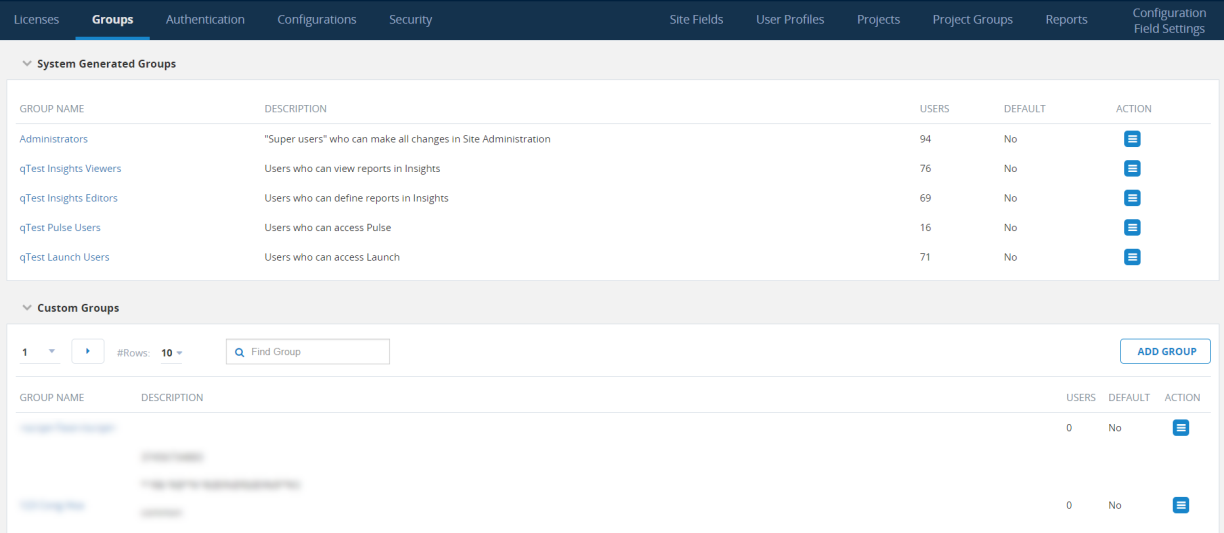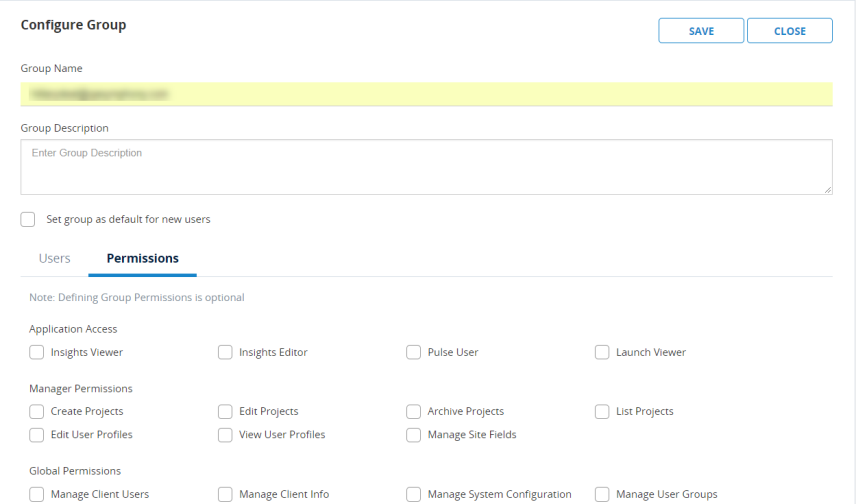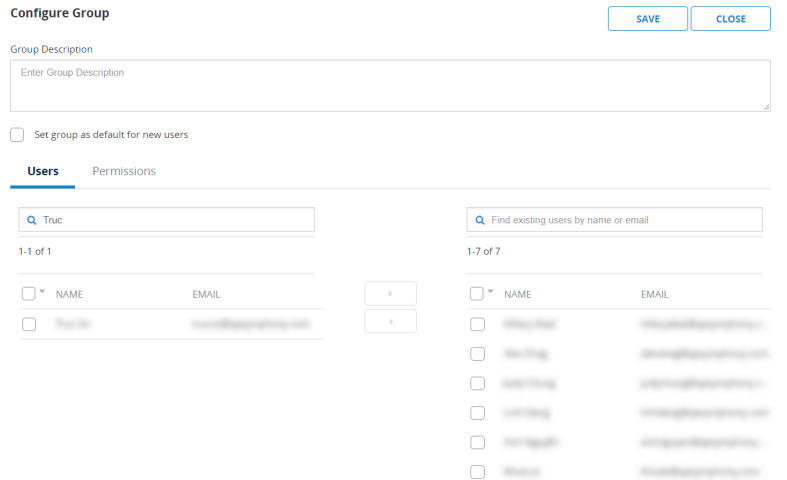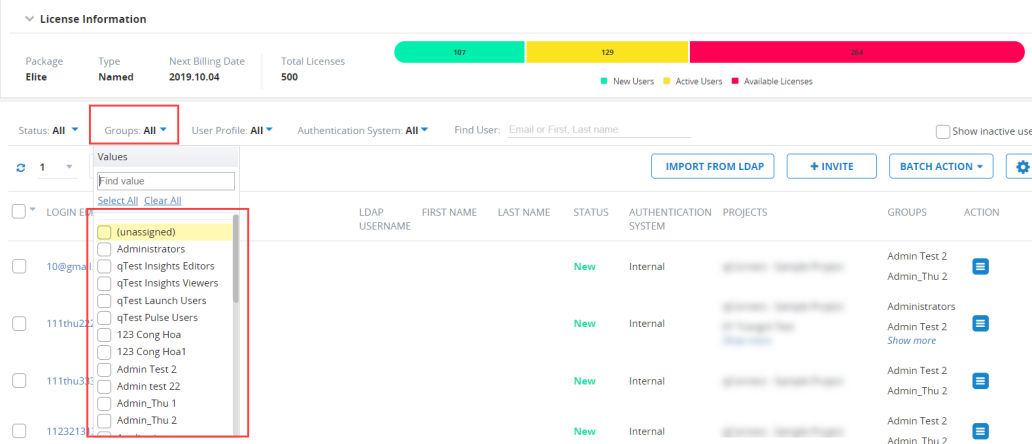User Groups
User Groups provide qTest Site Administrators the ability to apply bulk changes to User permissions, across projects. qTest offers pre-defined User Groups by default, but also allows Site Administrators to create custom User Groups, either from scratch or by editing an existing a pre-defined group.
User Groups Video
Why Use User Groups?
User Groups makes Administrators' lives easier by allowing them to easily assign batches of permissions to batches of users. Upon assigning a user to a User Group, all permissions associated with that User Group will be granted to the individual user.
-
For example, U-1 will have permissions A-F given:
U-1 is added to UG-1 and UG-2
UG-1 has permissions A, B, and C
UG-2 has permissions D, E, and F
The User Group concept also allows Site Administrators to sort and search for existing users by using "permission-less" User Groups. These 'permission-less groups' enables you to tag and organize users, for example, bytheir role in an organizations structure. i.e. QA User, QA Lead, Project Admin, etc. On the Licenses and Users page, Administrators can filter large lists of users by these permission-less groups.
Prerequisites
To manage and add users to User Groups, you will need the Manage User Groups permission.
The pre-defined User Groups and their permissions are as follows:
-
Administrators: Super users who can perform any site level configurations
-
qTest Insights Viewers: Users who can view reports in qTest Insights
-
qTest Insights Editors: Users who can define reports in qTest Insights
-
qTest Pulse Users: Users who can access qTest Pulse
-
qTest Launch Users: Users who can access qTest Launch
Take Note
-
Administrators who have already set up Admin Profiles do not have to worry about the introduction of User Groups,as all existing Admin Profiles will be migrated into new Custom User Groups.This way, Project Administrators will not have to start from scratch in defining new sets of user permissions.
-
In a Sessions Only package, the only pre-defined User Group available is System Administrators. Administrators cannot modify or create new User Groups.

Create User Groups
To create User Groups, follow these steps:
-
In qTest Manager, select Administration in the User Profile drop-down menu.
-
The License Information page displays and select the Groups tab in the header menu.
-
The Groups page displays. Select the ADD GROUP icon located in the "Custom Groups" section.
-
On the Configure Group page enter your Group Name and Group Description in the corresponding text-fields.
-
OPTIONAL: You can set this User Group as the default for new users by selecting the "Set group as default for new users" checkbox.
-
Under the Permissionstab, select the Group Permissions for your User Group.
-
If you want to go ahead and add users to this group now, follow the steps in the next section. If not, select Save.

Individual Group Level Permissions
When configuring a User Group, you can set individual group level permissions (as seen in the above screenshots). The permissions associated with each are the following:
-
Application Access: When a user is added to qTest they automatically have access to Manager and Parameters, but they won’t have access to Insights, Pulse or Launch unless configured below.
Insights Viewer: When checked by itself, it is a read-only license for Insights. Users can only view pre-built and custom reports, but they cannot change the content of these reports.
Insights Editor:This permission requires viewer access. It allows users to create and view reports within Insights.
Pulse User: viewing and editing access within Pulse
Launch Viewer: read-only access within qTest Launch
-
Manager Permissions: When a user is added to qTest they can be assigned to an Admin profile (User Group) to manage items within each one of the Admin tabs. This section is Manager-related only.
Create Projects: Allows the Admin to create new projects in the system. The add-new-project and clone-from-existing-project icons become available, but editing is not allowed. It gives access to the Projects, project Groups and Reports Tabs.
Edit Projects: Allows user to edit project info, such as name of project, date, project admin, etc. Because the user can edit projects, they are also able to create new projects and clone. The project name will turn blue in the list, indicating editing is allowed. It gives access to the Projects, Project Groups and Reports Tabs.
Archive projects: Allows user to Delete Projects. The list has now an “x” by the Action column, indicating the ability to delete the project. It gives access to the Projects, Project Groups and Reports Tabs.
List Projects: gives the ability to view the list of projects that have been added to the system, but creation, cloning or deletion of projects is not available.
Edit User Profiles: Allows admin to create new User Profiles. It gives access to add, edit and delete User Profiles (except for the out of the box profiles). User profiles, Project Groups , and Reports tabs are shown for the admin that has this permission.
View User Profiles: Allows admin to view User Profiles. They cannot add a new one, nor edit or delete existing ones. Though they push updated profiles to existing projects by using save-&-apply option. It gives access to User Profiles, Project Groups, and the Reports tabs.
Manage Site Fields: gives access to add, edit and push new fields to multiple projects. A way to manage fields at the admin level. However, it does not work when selected by itself. You MUST use another item from the Manage Permission section for this to work (such as create projects).
-
Global Permissions: manage permissions at the global level. This section refers to more administrative items, such as company profile name, SSO integration access, password policy, etc.
Manage Client Users:all the Manager permissions become selected (see the previous section to determine what permissions have been added).
Manage Client Info:admin only has access to the client info page.
Manage System Configuration:gives access to the Authentication, Configurations, Projects Groups, Reports and Configuration Field Settings Tabs.
Manage User Groups: gives access to Groups, Project Groups, and the Reports Tabs.
Assign User Groups
-
In the Administration section of Manager, select the Groupstab. The Groups page displays.
-
The Groups page is comprised of two sections: System Generated Groups and Custom Groups. Users can be added to either group. To assign a user to a group, select the Actionicon next to the System Generated Group or Custom Group of your choice.
-
Select the Users tab on the Configure Group page.
-
The left column provides you with all of the users for your qTest environment. You can search for and add users by name or email.
-
Once you find the user(s) that you want to assign to your User Group, select the checkbox next to their name(s), and then the right arrow icon to move them into the list of users in that User Group.
You can also use your tab key to select the right-arrow and the Enter key to move the usernames to the Selected column. -
Save.

Edit Existing User Groups
Site Administrators can also edit existing User Groups.This feature allows administrators to select and de-select permissions associated with their User Groups and also add and subtract users assigned to the groups.
To edit User Groups,follow these steps:
-
In Administration, select the Groups tab and the User Groups page displays.
-
Locate the User Group that you want to edit.
-
Select the Action icon for that group, and select edit.
-
The Configure Group page displays, and from here you can change the properties of the User Group.
-
Select Save.
Filter Users by User Groups
The User Groups feature also allows Administrators to search for an individual user or groups of users by using their associate dUser Group(s) as a filter. To do so, follow these steps:
-
In Administration, select the Licenses tab and the License Information page displays. The page contains a list of licensed qTest users.
-
In the list of usernames, there is a column header called 'Groups' that will display the group(s) an individual user is associated.
-
To filter users by User Group(s),select the Groups drop-down menu located in the action header under the License Information section.
-
Select the checkbox(es) associated with the User Group(s) you want to use as your filter.
-
The License Information page then populates the users assigned to the User Group(s) you selected.

Delete a User Group
Site Administrators can delete User Groups.To do so, follow these steps:
-
In Administration, select the Groups tab and the User Groups page displays.
-
In the Custom Groups section of the page, locate the Custom User Group from the list that you want to delete.
-
Select the Action icon for that User Group, and select Delete.
Use Case
Using Permission-less Groups
I am a Site Administrator and in charge of several hundred users. Within this large group of users, there are several teams, each defined by their roles within projects. One of these teams is the development team.
To better manage this team, I want to group them together in a User Group within qTest. This Group has nothing to do with the permissions that each user has, but rather serves as a sorting tool so that I can separate these developers from another team of users.
So, I create a User Group, name it "Developers," describe this group as “Our development team,” and I do not set any permissions.
